In this article
Petzl offers a diverse range of climbing harnesses, and choosing the right Petzl climbing harness is crucial for comfort, performance, and safety for any climber. This guide will help you navigate Petzl’s lineup, understand their technologies, and select the ideal harness for your climbing needs. We will explore why Petzl is a trusted name in climbing gear, decode their innovative harness technologies, discover top harnesses for various disciplines, and cover essential fitting and maintenance practices for your harness.
Why Choose a Petzl Climbing Harness?
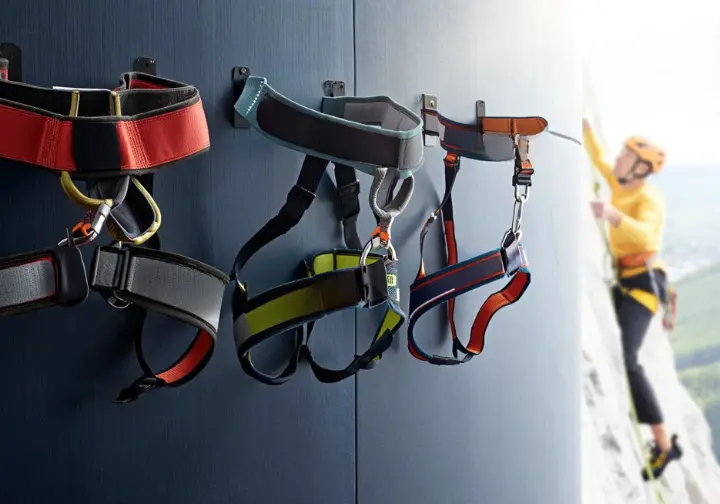
This section explores Petzl’s longstanding reputation for innovation, quality, and commitment to climber safety, which is reflected in their diverse harness collection. Understanding this background can help you appreciate the design and engineering that go into each Petzl rock climbing harness.
Petzl’s Dedication to Climbers
Petzl has been a leader in climbing gear innovation for decades, consistently improving design, materials, and safety standards in their equipment. This long history has built a strong foundation of trust among climbers globally. The brand’s commitment is evident in a harness collection designed to cater to a wide spectrum of climbing disciplines, from indoor gym climbing to demanding alpine expeditions. This ensures that climbers can find critical gear specifically tailored to their climbing activities. Petzl harnesses range from designs focusing on comfort and adjustability for general use to highly specialized, ultra-lightweight mountaineering harnesses engineered for elite performance and specific environments. This diversity in different harnesses addresses the nuanced needs of different climbers.
A deep understanding of the climber’s interaction with the vertical world is embodied in Petzl harnesses, showcasing thoughtful features and advanced technologies. This user-centric approach is a hallmark of their design philosophy. Ongoing research and development are central to Petzl’s strategy, ensuring each harness optimizes load distribution, enhances freedom of movement, and maximizes durability for reliable performance. This continuous improvement directly benefits the end-user. Choosing a Petzl climbing harness means investing in equipment backed by extensive expertise and a relentless pursuit of excellence in climber safety and overall performance. This provides peace of mind for a critical piece of safety gear. Petzl’s legacy is built not just on products, but on a commitment to supporting the climbing community through education and safety initiatives, further solidifying their trusted status. You can learn more about Petzl’s commitment to quality and further your knowledge by understanding climbing safety standards. The importance of gear in climbing cannot be overstated, especially when considering an arness climbing petzl. For a broader view, consider reading about selecting essential climbing equipment and understanding crucial harness components.
Innovation in Harness Design
Petzl consistently pushes the boundaries of harness design by exploring new materials and construction techniques to enhance performance and safety. This innovative spirit leads to lighter, more comfortable harnesses, and more durable harnesses. The evolution of their harness technologies shows a clear progression from traditional padding-focused designs to sophisticated structural engineering. This reflects a deep understanding of biomechanics and material science relevant to climbing. Petzl integrates advanced features aimed at optimizing load distribution, which is crucial for comfort during prolonged hanging or when catching falls during rock climbs. This focus significantly improves the climbing experience.
Freedom of movement is another key area of Petzl’s innovation, with designs that allow climbers to move naturally and efficiently without restriction. This is especially important for dynamic climbing styles. Durability is a non-negotiable aspect, and Petzl invests in materials and construction methods that ensure their harnesses can withstand the rigors of climbing. This commitment to longevity provides better value and sustained safety. The development of proprietary technologies like ENDOFRAME, FUSEFRAME, WIREFRAME, and MATRYX® demonstrates Petzl’s leadership in harness innovation. Each technology offers specific benefits tailored to different climbing demands, from sport-climbing to technical climbing. User feedback and collaboration with professional climbers play a significant role in Petzl’s R&D process, ensuring that new designs meet real-world needs and expectations. For more on advancements in climbing gear technology and materials science in protective equipment, these resources offer further insight. Understanding the biomechanics of climbing movements can also deepen your appreciation for these designs. You can explore innovations in climbing safety gear and learn about matching ropes with harness technology for a complete picture of your climbing gear system.
Decoding Petzl Harness Technology: The Science of Support
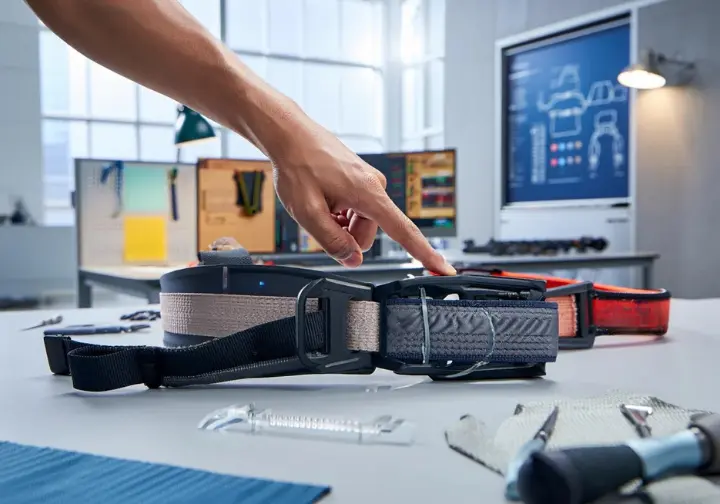
Understanding Petzl’s proprietary harness construction technologies is key to selecting a model that perfectly balances comfort, support, low weight, and durability for your specific climbing needs. Each technology offers a different approach to how the harness interacts with your body and manages loads during climbs.
ENDOFRAME Technology Explained
ENDOFRAME Technology is engineered to distribute pressure effectively across the waistbelt and leg loops, significantly enhancing comfort. This is particularly beneficial during prolonged hanging, such as on multi-pitch routes with a hanging belay or when working a sport route. It utilizes a double webbing frame structure, a type of load-bearing strap system, that helps to spread the load over a wider area of the body. This structural design minimizes pressure points that can cause discomfort or restrict blood flow. The anatomical shaping of the waist belt and leg loops complements the double webbing frame, conforming to the body for a more supportive and comfortable harness fit. This ergonomic approach reduces shifting and ensures the harness stays in place.
Harnesses incorporating ENDOFRAME Technology, such as the Petzl ADJAMA, LUNA, Petzl SAMA, SELENA, and the kids’ MACCHU, often combine it with padded belts and leg loops. This pairing offers a balance of structural support and cushioning. The primary goal of ENDOFRAME is to provide supportive cushioning without adding excessive bulk or weight to the harness. This makes it suitable for various climbing disciplines where comfort over extended periods is essential. This technology represents an evolution from simpler padding solutions by incorporating a more engineered approach to load distribution and wearer comfort. The design aims to prevent the harness from digging into the user’s sides or groin, which is a common issue with less advanced harness constructions, potentially leading to an uncomfortable harness. For insights into the principles of pressure distribution in equipment and ergonomic design in outdoor gear. Understanding comfort factors in climbing harnesses can further inform your choice. You might also explore specialized harness comfort and support and harness technology for women’s comfort.
Understanding FRAME Technology
FRAME Technology, featured in models like the Petzl ADJAMA, LUNA, Petzl SAMA, SELENA, and the Petzl Corax series, also prioritizes optimal weight distribution between the waist belt and leg loops. This is crucial for reducing fatigue and improving comfort during climbs. While specific construction details can vary between many harnesses, the core principle involves a structural design that ensures the load is borne efficiently by the harness’s framework. This enhances hanging comfort, especially when weighted. For example, the Petzl ADJAMA uses FRAME Technology to achieve effective weight distribution, which is complemented by tapered waist and leg loops. These tapered shapes are designed to avoid interference and digging in.
Smooth-seamed edges on the waistbelt and leg loops are often part of harnesses with FRAME Technology, further contributing to comfort by minimizing chafing points. This technology aims to provide a supportive yet comfortable harness experience, balancing structural integrity with wearer comfort for all-around climbing activities. The Petzl Corax harness, known for its adjustability, utilizes FRAME technology to provide comfort suitable for new climbers and all-around use, making it a great gym harness for some. FRAME Technology often results in harnesses that feel robust and secure, inspiring confidence in the gear’s ability to handle loads effectively. To delve deeper into load distribution in safety equipment or design principles for adjustable harnesses, these resources are helpful. Considerations around harness structural integrity are also key. For those starting out, learning about harness technology for beginner climbers is beneficial, as are the key features of modern climbing harnesses.
FUSEFRAME Technology: Sleek & Light
FUSEFRAME Technology represents a significant step towards creating lighter weight harnesses with sleeker, more minimalist profiles without compromising comfort. This is ideal for climbers looking to reduce bulk. This technology utilizes a construction method that incorporates closed-cell thermoformed foam, which provides consistent comfort throughout the harness’s lifespan. Unlike open-cell foam, it resists compression and moisture absorption. A key characteristic of FUSEFRAME is the fusing of fabric and foam layers without creating crossing straps. This helps prevent friction zones and minimize potential pressure points against the body.
The result is a harness, like the Petzl Aquila, Petzl Hirundos, and the modular Petzl Fly, that offers excellent freedom of movement due to its slim and clean design. This is particularly beneficial for dynamic moves and technical climbing. Even when hanging, harnesses with FUSEFRAME maintain a good level of comfort relative to their low profile and weight. The Petzl Fly harness showcases the adaptability of FUSEFRAME by incorporating removable foam, allowing users to customize the balance between comfort and weight for specific objectives, making it a very versatile harness. This technology enables Petzl to produce harnesses that are both highly supportive and surprisingly lightweight, appealing to performance-oriented climbers. Considering lightweight gear for mountain climbing can also be useful for your climbing adventure.
WIREFRAME Technology: Minimalist Support
WIREFRAME Technology, utilized in high-performance harnesses like the Petzl Sitta and the minimalist Petzl Altitude, offers a distinct approach to load distribution. It focuses on achieving support without traditional padding. It employs strategically placed High-Modulus Polyethylene (HMPE) strands within the thin waistbelt and leg loops. These strands are incredibly strong and lightweight. These HMPE strands provide optimal load distribution without the need for foam padding, resulting in extremely thin, flexible, and lightweight specialty harness designs. This minimizes bulk under clothing or packs.
Harnesses with WIREFRAME technology offer remarkable freedom of movement, making them practically unnoticeable when worn. This is a significant advantage for technical climbing and fast-and-light alpine climbing. Despite their minimal bulk, these harnesses are surprisingly comfortable when weighted, effectively dispersing pressure through the HMPE strand network. This technology is ideal for alpinism, ice climbing, and ski mountaineering where low weight and minimal bulk are paramount. The Petzl Sitta harness, often lauded in climbing-centric reviews as an uber-versatile Petzl Sitta, is an example of WIREFRAME, praised for its balance of ultralight design and functional features, making it versatile across disciplines. For related gear, consider specialized gear for mountaineering and ultralight gear for alpine conditions.
MATRYX® Technology: The Ultralight Revolution
MATRYX® Technology represents Petzl’s latest evolution in harness construction, debuting in the ultra-lightweight mountaineering harness known as the Petzl Whisper. It focuses on extreme weight savings and performance. This revolutionary stiff fabric features a strategic weave of individually coated High-Modulus Polyethylene (HMPE) and polyamide/nylon yarns. This combines strength with abrasion resistance. This unique construction makes MATRYX® harnesses exceptionally durable, highly breathable, and hydrophobic, meaning they shed moisture and stay light in all conditions. This is crucial for alpine climbing and ice climbing.
Unlike traditional multi-layer harness constructions, MATRYX® allows for a streamlined two-layer design: a weight-bearing layer of Matryx® fabric and an inner comfort layer. This reduces bulk and complexity. Horizontal HMPE fibers within the MATRYX® fabric manage load distribution effectively, while vertical fibers create flexible and comfort zones. This delivers support and freedom of movement with minimal weight. The technology provides exceptional abrasion resistance, a key factor for durability in harsh climbing environments, despite its incredibly low weight. The Petzl Whisper harness, utilizing MATRYX®, pushes the boundaries of ultralight design, offering top-tier performance for demanding climbers where every gram is critical. You may also be interested in the durability of lightweight materials and gear that stays light in all conditions.
Petzl Harness Categories & Top Models: Finding Your Perfect Match
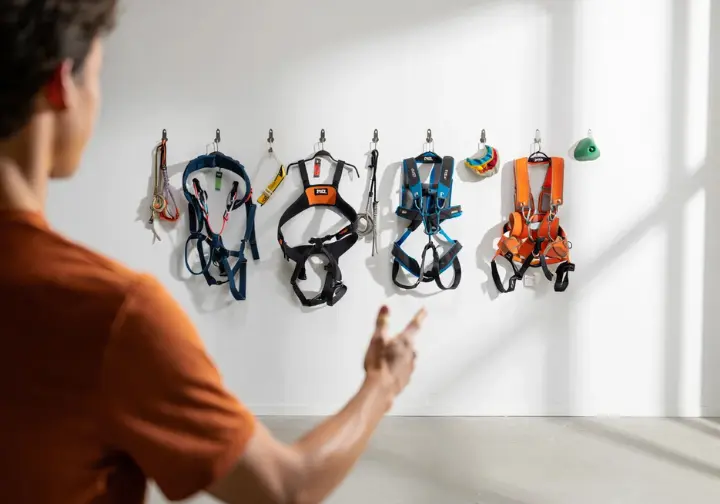
Petzl categorizes its harnesses to suit different experience levels and climbing intensities, making it easier to find a model that excels in your specific discipline. We’ll explore top harnesses based on common climbing scenarios, whether you need an all-around harness or mountaineering-specific harnesses.
All-Arounders: Trad, Multi-Pitch & Cragging
These harnesses prioritize comfort for long days, ample gear storage, and adaptability for various rock types and seasons. They are built to handle a variety of situations without specializing too narrowly, making them versatile harnesses.
ADJAMA (Men’s) | Versatile workhorse, high gear capacity, comfortable for long days
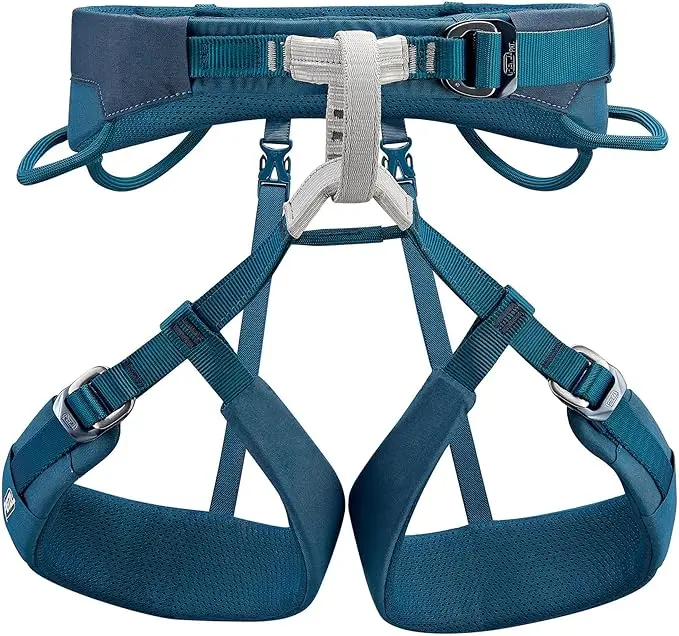
The Petzl ADJAMA is a men’s climbing harness engineered for versatility and durability, making it a solid choice for sport climbing, trad climbing, multi-pitch climbing, mountaineering, and ice climbing. It features EndoFrame Technology with a wide, padded waistbelt and leg loops for even load distribution and all-day comfort; breathable foam and perforated fabric enhance ventilation. It’s equipped with adjustable DoubleBack buckles on both the waistbelt and leg loops for a quick, precise fit. For gear, it offers five gear loops (two rigid front gear loops, two flexible rear, one accessory rear) and two CARITOOL slots, providing ample space. Dyneema tie-in points with red wear indicators ensure safety. The Petzladjama harness weighs approximately 17.1 oz (485 g, size M).
Reason to Buy: The Petzl ADJAMA is an excellent gear choice for intermediate to advanced climbers seeking a highly versatile harness, comfortable, and durable workhorse that can handle substantial gear for trad climbing, multi-pitch climbing, and even ice climbing adventures, truly a fully-featured harness and a great four-season harness.
PROS
- Extremely versatile for sport climbing, trad climbing, ice climbing, and multi-pitch climbing.
- Very comfortable harness for long days and hangs due to EndoFrame padding and wide waistbelt.
- High gear capacity with five gear loops (including huge gear loops by some standards) and two CARITOOL slots for good gear organization.
- Durable construction with robust Dyneema tie-in points featuring wear indicators.
CONS
- Can be less breathable than mesh-heavy designs, potentially warm in summer.
- DoubleBack buckles require manual threading, which can be fiddly for some users.
- Rear gear loops may sag if heavily loaded with a large rack of gear.
- Sizing can run small for some, and it’s slightly heavier than highly specialized harnesses.
LUNA (Women’s) | Women-specific ADJAMA, excellent fit, versatile, high gear capacity
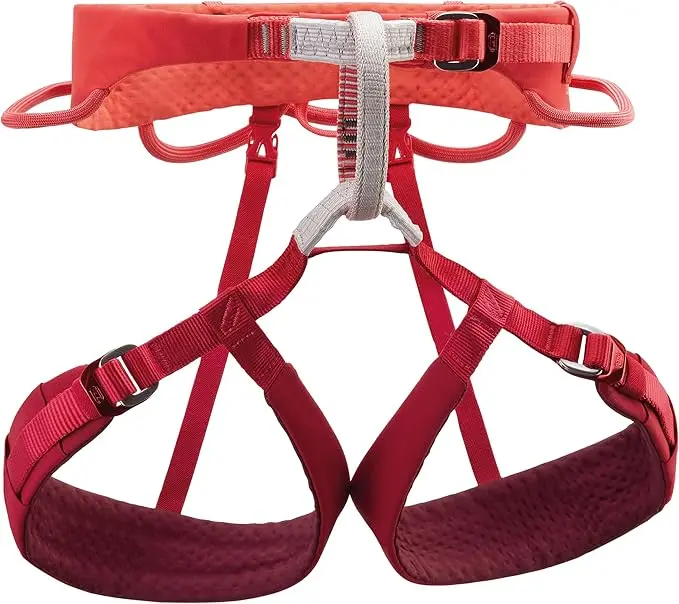
The Petzl LUNA is the women-specific version of the ADJAMA, designed to offer an excellent fit, versatility, and high gear capacity for female climbers across sport climbing, trad climbing, multi-pitch climbing, mountaineering, and ice climbing. It employs EndoFrame Technology with a contoured, padded waistbelt and flexible leg loops specifically tailored to female anatomy (e.g., higher waistbelt, longer leg loop rise) for optimal load distribution and all-day comfort. Adjustable DoubleBack buckles on the waistbelt and leg loops ensure a precise fit. It features five gear loops and two CARITOOL slots, similar to the ADJAMA. Dyneema tie-in points with red wear indicators are standard for safety. It weighs approximately 16.6 oz (470 g, size M). This is one of the great harnesses for women.
Reason to Buy: The LUNA is ideal for intermediate to advanced climbers (women) needing a versatile harness, gear-heavy harness that provides a comfortable, anatomically sound fit for extended trad routes, multi-pitch climbs, and mountaineering.
PROS
- Tailored women-specific fit for enhanced comfort and security, contoured to female anatomy.
- Harness versatile for a wide range of climbing disciplines including trad climbing, multi-pitch, and ice.
- Comfortable harness for long days and hangs due to women-specific EndoFrame design.
- High gear capacity with five gear loops and two CARITOOL slots.
CONS
- Can be less breathable in very hot conditions compared to more minimalist designs.
- DoubleBack buckles require manual threading, which some users find less convenient.
- Rear gear loops may sag if heavily loaded with equipment.
- Sizing can run small for some individuals, and it is slightly heavier than sport-climbing specific harnesses.
Engineered for Agility: Sport Climbing & Gym
These harnesses prioritize light weight, freedom of movement, and sufficient comfort for projecting routes and gym sessions. They are designed for dynamic movement and shorter hang times compared to all-around or alpine harness models, making them suitable for sport climbing and climbing gym use.
SAMA (Men’s) | Very comfortable for sport/gym, great freedom of movement, excellent value
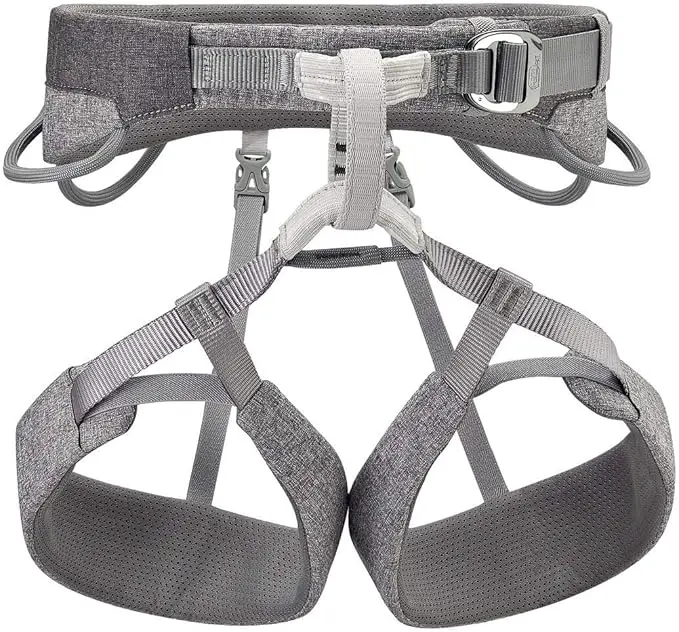
The Petzl SAMA (often searched as petzlsama harness) is a men’s lightweight climbing harness designed with a strong emphasis on comfort, freedom of movement, and excellent value, making it particularly well-suited for sport climbing and gym climbing. It incorporates EndoFrame Technology with a padded waistbelt and elasticated leg loops for even load distribution and comfort during hangs. An adjustable DoubleBack buckle on the waistbelt allows for a quick fit. It offers four gear loops (two rigid front gear loops, two flexible rear). Dyneema tie-in points with red wear indicators are included for safety. The Petzl Sama weighs around 13.8 oz (390 g, size M).
Reason to Buy: The Petzl SAMA is an excellent choice for beginner to intermediate climbers who primarily engage in sport climbing or gym climbing and want a comfortable harness, agile, and well-priced harness that allows for great freedom of movement.
PROS
- Very comfortable harness for sport climbing and gym sessions, especially during hangs.
- Excellent freedom of mobility due to its design and elastic leg loops.
- Lightweight design enhances agility and reduces bulk, good for hard sport-climbing.
- Great value for a performance-oriented sport climbing harness.
CONS
- Limited gear capacity with four loops, less suitable for trad climbing.
- Elastic leg loops may stretch or lose some elasticity over extended use.
- No haul loop or dedicated ice clipper slots, limiting its versatility for other disciplines like ice climbs.
- Waist buckle requires manual threading.
SELENA (Women’s) | Women-specific SAMA, comfortable for sport/gym if hip-fit preferred
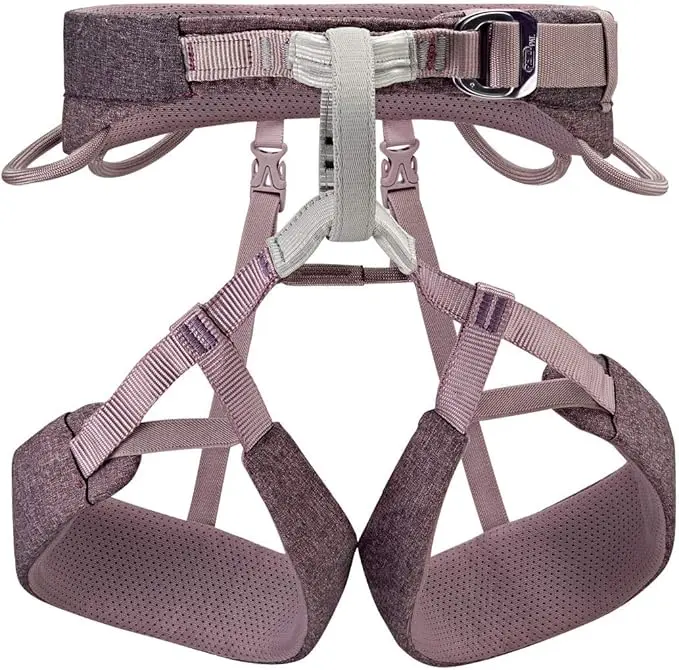
The Petzl SELENA is the women-specific version of the SAMA, engineered for comfort in sport climbing and gym climbing, particularly for those who prefer a harness that sits higher on the hips. It utilizes EndoFrame Technology with a contoured, padded waistbelt and elastic leg loops tailored to female anatomy (longer rise, angled waistbelt). An adjustable DoubleBack buckle on the waistbelt ensures a precise fit. It features four gear loops and a rear accessory loop. Dyneema tie-in points with red wear indicators are standard. Its weight is approximately 13.7 oz (390 g, size M), and its exterior uses 100% recycled polyester.
Reason to Buy: The SELENA is an excellent option for beginner to intermediate women climbers focusing on sport climbing and gym climbing who prioritize a comfortable harness, anatomically designed harness with an eco-conscious element and prefer a fit that cinches higher on the waist.
PROS
- Women-specific fit designed for female anatomy, especially a higher hip fit.
- Comfortable harness for sport climbing and gym use, with good freedom of movement.
- Lightweight and offers excellent value for a specialized women’s harness.
- Eco-friendly design with recycled polyester in the waistbelt and leg loop exterior.
CONS
- Limited gear capacity with four loops, not ideal for gear-intensive trad climbing.
- Elastic leg loops may stretch over time with frequent use.
- No dedicated haul loop or standard ice clipper slots.
- Waist buckle requires manual threading.
Alpine, Mountaineering & SkiMo Specialists
Engineered for mountain environments, prioritizing low weight, packability, and features for snow, ice, and mixed terrain. These mountaineering harnesses are for climbers who need minimalist designs that perform in harsh conditions, including alpine climbing and mountaineering practice.
SITTA | Apex all-arounder, ultralight, extremely versatile, great features for all disciplines
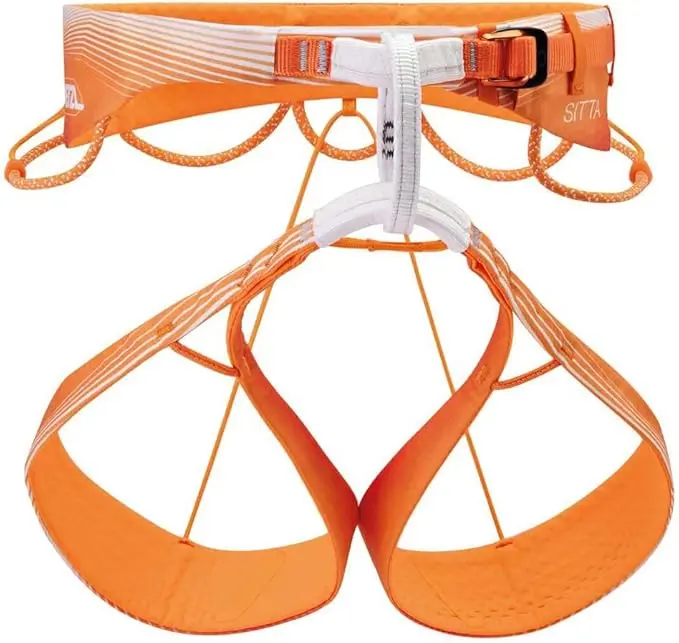
The Petzl SITTA (sometimes searched as petzlsitta harnesstop or petzlsitta) is an ultra-lightweight mountaineering harness, high-performance unisex harness designed for versatility across sport climbing, trad climbing, multi-pitch climbing, mountaineering, and ice climbing, ideal for advanced climbers. It features WIREFRAME Technology with Spectra® strands for load distribution without foam, ensuring a sleek, compact design. A DoubleBack HD aluminum buckle allows smooth waistbelt adjustment. It boasts five gear loops (two rigid front gear loops with a sliding separator, two flexible rear, one accessory rear), two CARITOOL slots, and a haul loop. Dyneema tie-in points are reinforced. The Petzl Sitta weighs ~9.5 oz (270 g, size M) and uses eco-designed textiles, making it a piece of excellent gear.
Reason to Buy: The Petzl SITTA is the apex choice for advanced climbers seeking an exceptionally lightweight, packable, and versatile harness that excels across all disciplines, from hard climbing on sport routes to demanding alpine ascents, where performance and minimal weight are paramount.
PROS
- Ultralight and highly packable design, ideal for minimizing weight and bulk on alpine climbs.
- Extremely versatile harness for all climbing disciplines including technical rock, ice, and alpine.
- Excellent gear organization with five well-designed loops, including a front separator, and CARITOOL slots.
- Remarkable freedom of movement due to its minimalist construction.
CONS
- Minimal padding can be less comfortable for very long hangs or belaying heavier partners.
- Sizing can be tight for some in the waist, or leg loops may feel loose on smaller frames.
- High-priced harnesses like this reflect its high-performance features and materials.
- One user reported injury concern with prolonged hanging at higher weights, suggesting caution.
ALTITUDE | Streamlined, very light, packable, don with skis/crampons, for ski touring/mountaineering
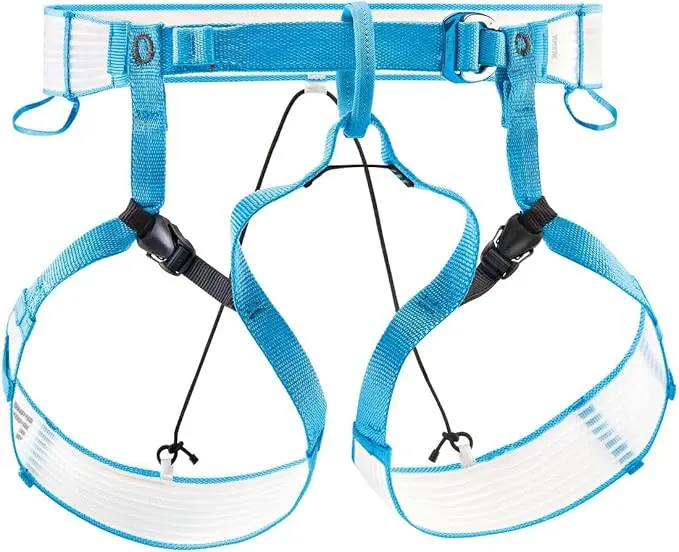
The Petzl ALTITUDE is an ultra-lightweight mountaineering harness, streamlined unisex harness specifically designed for ski touring, mountaineering, and alpine climbing, allowing it to be donned with skis or crampons on. It utilizes WIREFRAME Technology with HMPE strands for load distribution without foam, ensuring breathability and a weightless feel. A DOUBLEBACK LIGHT aluminum buckle and simple structure facilitate easy operation, even with gloves. It has two gear loops and silicone-lined ice screw keepers on leg loops, and includes a protective carry pouch. The Petzl Altitude weighs a mere ~5.3 oz (150 g, size S/M).
Reason to Buy: The Petzl ALTITUDE is the perfect choice for advanced ski mountaineers and alpinists who need the absolute lightest, most packable alpine harness that can be put on without removing skis or crampons, for fast-and-light objectives where every gram and second counts.
PROS
- Exceptionally ultralight and extremely packable, fitting into a tiny pouch.
- Can be easily donned and doffed while wearing skis or crampons.
- WIREFRAME design offers good breathability and comfort for walking or skiing.
- Sufficient gear capacity and ice screw keepers for lightweight alpine objectives.
CONS
- Minimalist design with no padding makes it uncomfortable harness for prolonged hangs or belaying.
- Limited gear capacity with only two main loops, not suitable for gear-intensive climbs.
- Sizing can run small, and the buckle, while glove-friendly, requires threading.
- Polyester tie-in points are less robust than Dyneema found on some other high-end technical harnesses.
For the Young Ascenders: Kids’ Petzl Harnesses
Specifically designed for children, focusing on adjustability for growth, comfort, and clear visual safety indicators. These harnesses help introduce young climbers to the sport safely.
MACCHU (Sit Harness) | Highly adjustable for growth, comfortable, ENDOFRAME, can add BODY straps
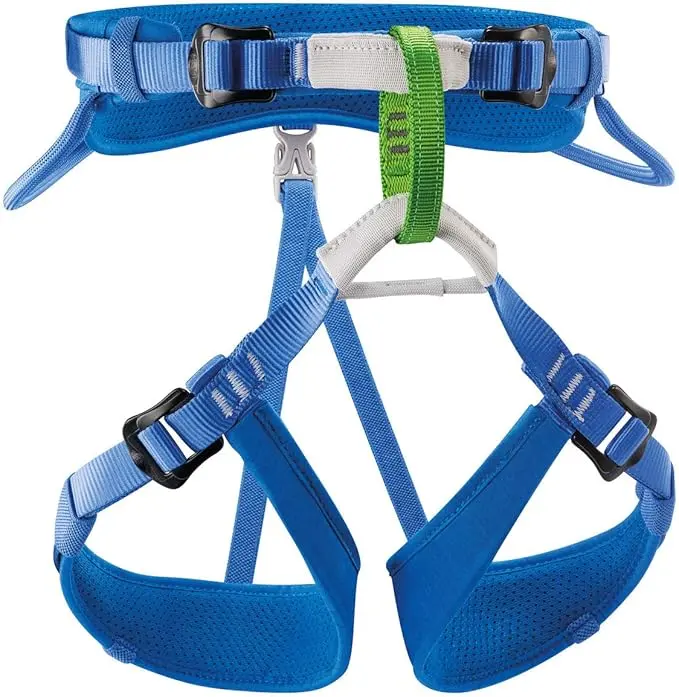
The Petzl MACCHU is an adjustable sit harness for children under 40 kg (88 lbs), offering adaptability, comfort, and safety for sport climbing and gym use. It features ENDOFRAME Technology with a padded waistbelt and leg loops for comfort and weight distribution. DOUBLEBACK buckles on the waistbelt and leg loops allow for precise adjustments for growing children. It has two tie-in points, a colored belay loop, two gear loops, and an accessory loop. Optional BODY shoulder straps can convert it to a full-body harness for smaller children. It weighs ~11.9 oz (335 g). These are comfortable seat harnesses for kids.
Reason to Buy: The MACCHU is an excellent choice for young climbers (approx. 3-12 years, under 40 kg) needing a comfortable, highly adjustable harness that can grow with them and offers the crucial option of adding BODY straps for enhanced safety, especially for those just starting their climbing adventure.
PROS
- Highly adjustable harness to accommodate growing children over several years.
- Comfortable for kids due to ENDOFRAME padding and no through-stitching design.
- Option to add BODY straps for increased safety for younger/smaller children.
- Kid-friendly design with easy-to-check colored belay loop and gear loops.
CONS
- Gear loops are relatively small, not ideal for carrying much trad gear.
- Buckles require adult assistance for proper threading and adjustment.
- BODY shoulder straps are an additional purchase, adding to the overall cost.
- Strict weight limit of 40 kg (88 lbs).
OUISTITI (Full Body) | For very young climbers (under 30 kg), specific full-body design
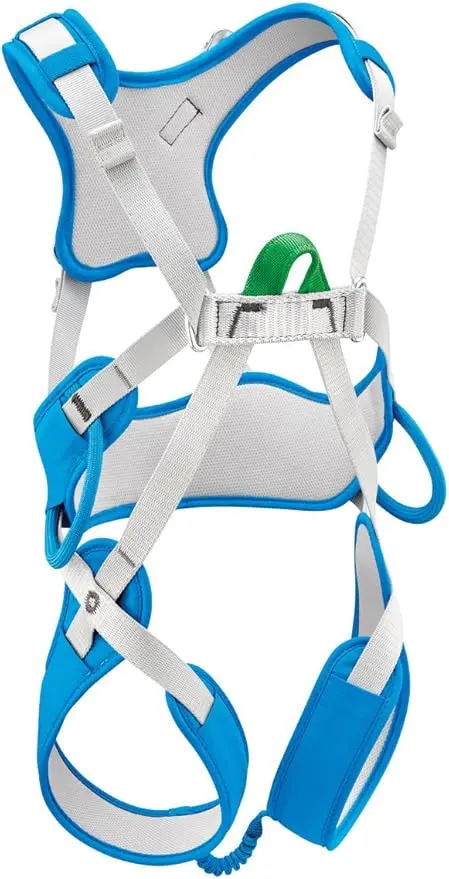
The Petzl OUISTITI is a full-body harness specifically designed for very young climbers (under 30 kg/66 lbs, typically ages ~3-8 years) to provide maximum safety and comfort. It features a semi-rigid structure with padded foam on the waist, thighs, and shoulder straps. Color-coded straps (green front tie-in, orange rear attachment) simplify donning. DOUBLEBACK buckles on shoulder straps and back are positioned out of child’s reach for safety and ensure a snug fit without needing a carabiner to close. It has two gear loops and a rear accessory loop. It weighs ~14.5 oz (410 g).
Reason to Buy: The OUISTITI is the go-to harness for ensuring the safety and comfort of very young climbers (typically 3-8 years old and under 30 kg), where the inherent security of a full-body design is paramount for climbing activities like gym climbing, top-roping, and even hiking.
PROS
- Full-body design provides maximum security for very young or small children, preventing inversion.
- Comfortable due to padded foam structure on waist, thighs, and shoulder straps.
- Easy for parents to put on correctly thanks to color-coded straps and simple tie-in points.
- Versatile with front tie-in for climbing and rear attachment for other activities like rappelling.
CONS
- Non-adjustable leg loops can lead to a loose fit on very small or slender children.
- May be too large for children under ~25 lbs, despite the 30 kg weight limit.
- Buckles require adult assistance and are intentionally hard for kids to adjust.
- Heavier than a sit harness like the MACCHU, which might be noticeable for toddlers.
Dialing in the Fit: Sizing Your Petzl Harness Correctly
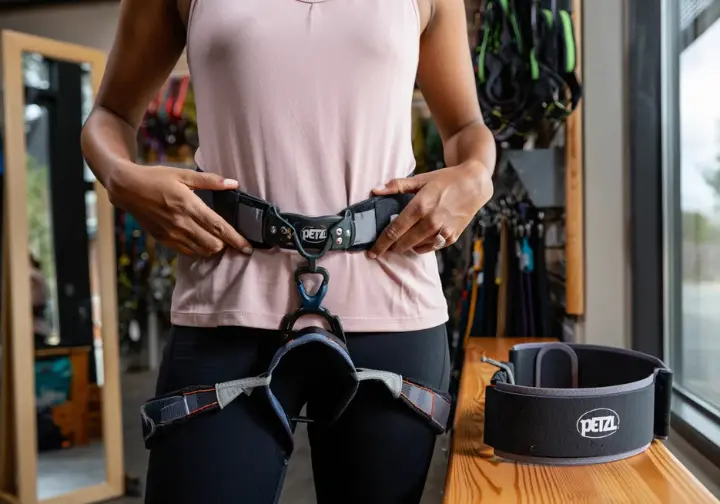
A correctly fitted climbing harness is absolutely paramount for safety, comfort, and optimal performance; an ill-fitting harness can be dangerous or restrict movement. Taking the time to find the right size and adjust it properly is a critical step for any climber.
Understanding Petzl’s Sizing Charts
Petzl provides specific sizing charts for each harness model, typically based on waist and leg loop circumference measurements in centimeters. These charts serve as the essential starting point for selection. It’s crucial to take accurate body measurements. Measure your waist above the iliac crest (hip bones) and your thighs at their thickest part to compare with the charts. User feedback across various Petzl models like Petzl ADJAMA, Petzl Hirundos, Petzl Aquila, and Petzl Altitude indicates that actual fit can sometimes differ from chart-based expectations. This highlights the charts are guidelines, not absolute guarantees. Individual body shape, muscle mass distribution, and personal preference for how snug a harness feels are factors not fully captured by simple circumference measurements. These variables can influence the ideal size for your climbing harness.
Therefore, while Petzl’s size charts are valuable, they should be used as a primary guideline, with the understanding that trying on the harness is the best way to confirm fit. Some harnesses, like the Petzl Corax, offer broader adjustability with features like dual waist buckles, making them more forgiving for a wider range of body types within their size brackets. For women’s specific harnesses like the LUNA or SELENA, the sizing considers different waist-to-leg loop ratios and rise, but individual variations still mean trying them on is best. You can learn about interpreting gear sizing charts for more details. For a broader understanding, refer to general harness fitting guidelines and the importance of women’s specific fit.
The Critical Hang Test for Petzl Harnesses
The “hang test,” where a climber is suspended in the harness, is the ultimate method to confirm a good fit and identify potential issues before purchasing. This simulates real-world loading conditions. When suspended, the harness should distribute your weight relatively evenly across the waistbelt and leg loops. There should be no excessive pressure points, sharp digging, or pinching, particularly around the waist, groin, or thighs. You should be able to sit upright comfortably in the harness, almost as if in a chair, without undue restriction or discomfort. This indicates good overall support and shaping.
Crucially, the waistbelt must remain securely positioned above your iliac crests (hip bones) and should not slip down or ride up significantly when weighted. This is a primary safety check for your climbing harness. You should not be able to pull the waistbelt down over your hips while hanging. A common check is ensuring you cannot fit more than a fist between your stomach and the hip belt when weighted. If permitted and done safely under supervision, slowly inverting (or leaning back significantly) can also test the waistbelt’s security and the harness’s overall stability. The hang test reveals comfort and security aspects that may not be apparent when simply standing or walking around in the harness. It’s especially important for evaluating hanging comfort for multi-pitch climbing or projecting routes with many hangs and belays. Learning about performing a harness hang test and assessing harness comfort under load can be very helpful. Familiarize yourself with general safety checks for climbing harnesses. Understanding the key elements of a proper harness fit and the importance of secure gear for belaying will reinforce this practice.
Common Fitting Pitfalls to Avoid
A harness that is too loose, especially the waistbelt, poses a significant safety risk. It can allow a climber to slip out, particularly during an inverted fall from a cliff or wall, which could have catastrophic consequences. Conversely, an overly tight harness, whether the waistbelt or leg loops, can severely restrict movement, cause painful chafing, and even impair circulation. This impacts both comfort and performance. Incorrect waistbelt positioning is a common error. If the waistbelt is worn on or below the hip bones (iliac crests), it can slip upwards during a fall or downwards if inverted, compromising safety. It should always be above the hip bones.
Focusing solely on waist circumference and neglecting leg loop fit is another pitfall. Leg loops that are too tight restrict mobility and cause discomfort, while too loose leg loops may not provide optimal support during a fall or when hanging. When selecting harnesses intended for all-season use or mountaineering (e.g., Petzl ADJAMA, LUNA, Petzl Aquila, alpine harness models), climbers must account for additional clothing layers. The harness should fit correctly with these layers without becoming too restrictive or maxing out the buckles. While not an absolute rule, choosing a gender-specific design if available (like Petzl LUNA for women) often leads to a better, more comfortable harness fit due to anatomical considerations in rise and waist-to-leg loop ratios. Ignoring this can lead to suboptimal fit for some individuals. Ensure buckles like Petzl’s DOUBLEBACK or DOUBLEBACK HD are correctly threaded and fully secured. For any manual double-back buckles, always ensure the webbing, a type of strap, is threaded back through the buckle correctly. Understanding the risks of an improperly fitted harness is critical. Knowing how to properly adjust harness buckles and considering layering clothing under a climbing harness are also important. Proper harness fit is part of foundational safety in rock climbing, and you should also be mindful of clothing considerations for climbing comfort.
Extending Your Harness Lifespan: Inspection, Care & Retirement
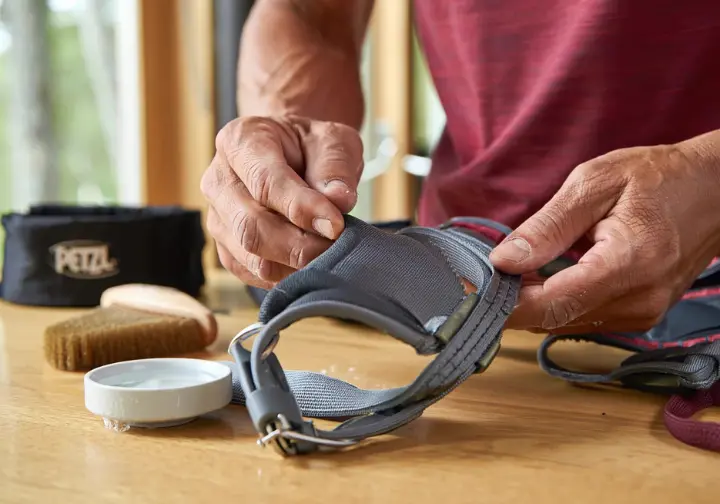
A climbing harness is a critical piece of personal protective equipment (PPE), and its integrity is non-negotiable for safety. Diligent inspection, proper care, and timely retirement are essential for all harnesses. How do you ensure your lifeline, your only harness for critical situations, remains trustworthy?
Pre-Climb Petzl Harness Inspection Routine
It is the climber’s responsibility to thoroughly inspect their harness before or after each use. This should become an ingrained habit for every climbing session. Petzl also recommends a more detailed inspection by a competent person at least every 12 months, especially for gear used frequently or in institutional settings. Examine all webbing on the waistbelt, leg loops, and structural straps for any cuts, nicks, tears, significant fraying, or abrasion. Pay extremely close attention to high-friction areas like tie-in points and where buckles sit. Look for any signs of chemical contamination (discoloration, stiffness), heat damage (hard or shiny spots, melted fibers), or swelling in the webbing. Flexing the webbing can help reveal damaged fibers not easily seen.
Inspect all structural stitching (bar tacks), often in a contrasting thread color, for any pulled, cut, worn, abraded, or missing threads. Compromised stitching can lead to harness failure. The tie-in points and belay loop are critical high-wear areas. Check them meticulously for cuts, fraying, excessive abrasion, or any signs of heat/chemical damage. Some Petzl harnesses have wear indicators (e.g., red fibers showing through) that signal retirement. Examine all adjustment buckles and metal hardware for cracks, sharp edges, deformation, corrosion, or excessive wear. Ensure buckles operate smoothly and that auto-locking buckles engage correctly. Familiarize yourself with official PPE inspection guidelines and perhaps a detailed harness inspection checklist. For specifics on recognizing wear on tie-in points, product information can be helpful. Gear inspection is a key part of safety protocols in climbing, and understanding gear performance in extreme conditions reinforces the need for vigilance.
Cleaning and Storing Your Harness
Proper cleaning and storage can significantly extend the usable life of your Petzl harness and help maintain its performance and safety. For light cleaning, wipe off loose dirt, chalk, and grime with a soft brush or a sponge dampened with plain water. Avoid abrasive scrubbing. If more thorough cleaning is needed, hand wash the harness in lukewarm water (maximum 30°C or 86°F). Use a mild, non-aggressive soap or a detergent specifically approved for synthetic fibers if absolutely necessary. Always rinse the harness thoroughly with clean water to remove any and all soap residue, as leftover detergent can degrade materials over time.
Never use a washing machine or dryer for your harness. The aggressive mechanical action and heat can severely damage the harness materials, webbing, and stitching. To dry, hang the harness freely in a shaded, well-ventilated area, away from direct sunlight or direct heat sources like radiators or fires. Ensure it’s completely dry before storing to prevent mildew. Store your harness in a cool, dry, dark place, protected from UV radiation (sunlight), chemicals (e.g., battery acid, solvents, gasoline), corrosive substances, and sharp objects. Using the protective carry pouch provided by Petzl is a good practice. Proper care is one of the main factors affecting harness lifespan, and it relates to managing chalk and gear cleanliness.
Knowing When to Retire Your Petzl Harness
Recognizing when a harness has reached the end of its safe service life is crucial for climber safety; this isn’t just about visible damage but also age and usage history. Petzl states a maximum lifespan of 10 years from the date of manufacture for its textile and plastic PPE, including harnesses, even if stored unused. The manufacturing date is usually found on a tag. The actual service life can be significantly shorter than 10 years depending on the intensity and frequency of use (from occasional climbing to regular climbing), and exposure to harsh conditions (e.g., frequent falls, abrasion, saltwater, chemicals, extreme temperatures). Any harness subjected to a major fall (Factor 1 or 2, or any fall with significant forces) should be carefully inspected and often retired immediately, even if no visible damage is apparent. Consult Petzl’s specific recommendations if in doubt.
Retire the harness immediately if inspections reveal: cuts, tears, significant fraying, or deep abrasions on load-bearing webbing or straps; damaged or cut safety stitching; excessively worn belay loop or tie-in points (wear indicator showing); or deformed, cracked, corroded, or malfunctioning buckles. Also retire if you find stiffened, glazed, or melted webbing from heat exposure, or chemical contamination causing changes in texture or color. If there is any doubt whatsoever about the harness’s condition, history, or integrity, the safest course of action is to retire it. The cost of a new harness is insignificant compared to the potential consequences of a failure. For a more in-depth look, read our detailed guide on harness lifespan and retirement, and remember this is part of inspecting all belay safety equipment.
Conclusion: Climb Confidently with Your Ideal Petzl Harness
Selecting the right Petzl climbing harness involves understanding your climbing style, Petzl’s technologies, ensuring a perfect fit, and committing to diligent care. From versatile all-arounders like the Petzl ADJAMA and LUNA to specialized alpine harnesses such as the Petzl Sitta and the groundbreaking Petzl Whisper, Petzl distribution offers a solution for nearly every climber and climbing discipline, including traditional climbing, sport climbing, and mountaineering. Aligning harness features—like adjustability, the number and type of gear loops, and construction technologies such as ENDOFRAME or MATRYX®—with your specific needs is crucial for both performance and safety on the rock or ice. Do you prefer more padding for long trad routes, or is an ultra-lightweight design for alpine missions your priority?
Always prioritize trying on a harness and performing a hang test before buying, as fit is paramount and can vary significantly between models and individuals, even with accurate measurements. By using this guide, you can make an informed decision, choosing a Petzl harness that not only enhances your climbing experience but also serves as a trusted piece of safety equipment for all your vertical rock climbs and adventure climbs to come.
Frequently Asked Questions about Petzl Climbing Harnesses
What is the main difference between Petzl’s ENDOFRAME and WIREFRAME technology? >
How do I know which Petzl harness is best for a beginner? >
Are Petzl women’s harnesses like the LUNA or SELENA really different from men’s/unisex models? >
How often should I replace my Petzl climbing harness? >
We are a participant in the Amazon Services LLC Associates Program, an affiliate advertising program designed to provide a means for sites to earn advertising fees by advertising and linking to Amazon.com. As an Amazon Associate I earn from qualifying purchases. We also participate in other affiliate programs. The information provided on this website is provided for entertainment purposes only. We make no representations or warranties of any kind, expressed or implied, about the completeness, accuracy, adequacy, legality, usefulness, reliability, suitability, or availability of the information, or about anything else. Any reliance you place on the information is therefore strictly at your own risk. Additional terms are found in the terms of service.











